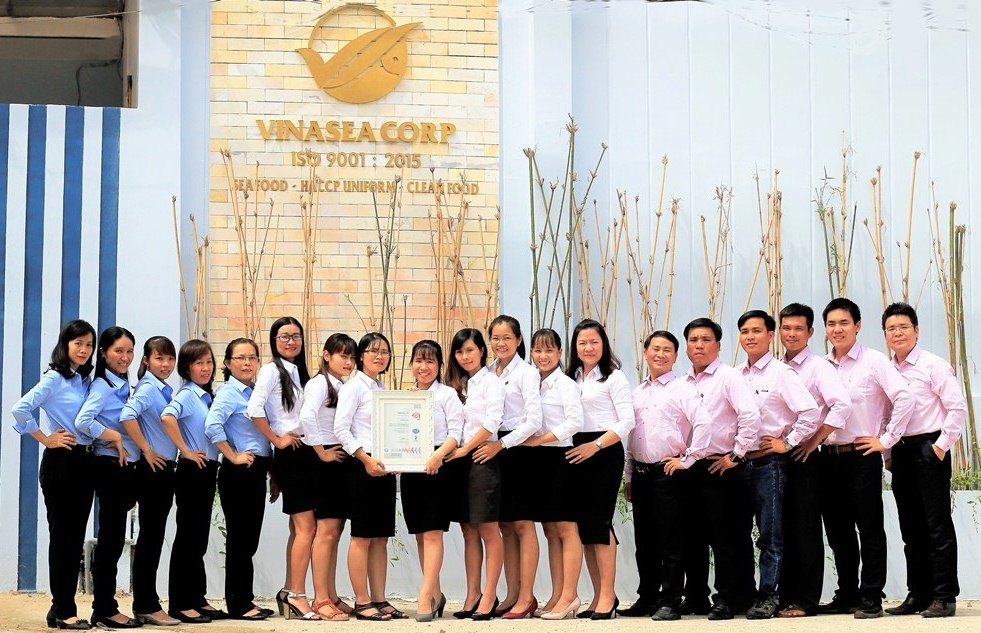CO-OPERATION MANUFACTURERS NETWORK
With 20 years experience in the field of seafood business and provide uniforms and protective wear for seafood industry, we have build a good relationship with over 300 seafood manufacturers in Vietnam. In particular, we are working closely with more than 25 selected seafood manufacturers to produce hundred high quality seafood items under VINASEA brand and customers brand (OEM). We believe that VINASEA can meet all the requirements of customers with high quality products on-time delivery traceability capable and most competitive price.
WHY CHOOSE US AMONG HUNDREDS SEAFOOD EXPORTERS IN VIETNAM?
 20 YEARS: EXPERIENCE IN VIETNAM SEAFOOD BUSINESS.
20 YEARS: EXPERIENCE IN VIETNAM SEAFOOD BUSINESS.
 25 RELATION MANUFACTURES NETWORK: CAN SUPPLY ALL YOUR NEEDED SEAFOOD FROM VIETNAM.
25 RELATION MANUFACTURES NETWORK: CAN SUPPLY ALL YOUR NEEDED SEAFOOD FROM VIETNAM.
 200 SHIPMENTS EVERY YEAR: QUALITY SATISFACTION AND IN-TIME DELIVERY.
200 SHIPMENTS EVERY YEAR: QUALITY SATISFACTION AND IN-TIME DELIVERY.
 100% CUSTOMER'S COMPLAINS: QUICK RESPONSE AND IMMEDIATE IMPROVEMENT ACTIONS.
100% CUSTOMER'S COMPLAINS: QUICK RESPONSE AND IMMEDIATE IMPROVEMENT ACTIONS.
 1ST SEAFOOD COMPANY IN VIETNAM: APPLY ON-LINE TRACKING SYSTEM (OTS) AND QUICK RESPONSE TRACEABILITY SYSTEM (QRTS).
1ST SEAFOOD COMPANY IN VIETNAM: APPLY ON-LINE TRACKING SYSTEM (OTS) AND QUICK RESPONSE TRACEABILITY SYSTEM (QRTS).
- Details
- Written by Super User
- Category: NEWS
- Hits: 1165
Vietnam’s pangasius industry is continuing to perform well this year, driven by rising demand from key markets – most prominently, China.
And its potential is even greater given the opportunities it sees as China and the United States continue to face off in an escalating trade war.
Pangasius is Vietnam’s second-biggest seafood export in terms of value, following shrimp. But the country’s dominance in production of the species makes pangasius the core issue of any strategic discussion in Vietnam’s seafood industry.
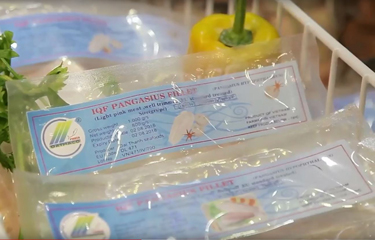
And the hot topic in the country these days is the escalating trade war between China and the U.S., which is being watched closely in the Southeast Asia nation.
“We have not been able to immediately assess all possible impacts from the trade war. But our initial thinking is that China and Vietnam are not direct competitors in exporting seafood to the U.S., as they import more than export,” Truong Dinh Hoe, general secretary of Vietnam Association of Seafood Exporters and Producers (VASEP), told SeafoodSource on the sidelines of the Vietfish conference and expo in Ho Chi Minh City during 22 to 24 August.
The country is on track to get more than USD 2 billion (EUR 1.72 billion) from pangasius exports this year, Vietnamese Agriculture Minister Nguyen Xuan Cuong said in a statement on 21 August.
Even with shipments to the United States dropping after the U.S. imposed high antidumping rates in March 2018, Vietnam actually improved its year-over-year gains from pangasius exports by 19.3 percent in the first seven months of this year, with the total value of those shipments reaching USD 1.2 billion (EUR 1 billion)
In July, the U.S. overthrew China to once again become the biggest pangasius buyer, as it spent USD 58.5 million (EUR 50.4 million) on pangasius – higher than China’s USD 38.4 million (EUR 33.1 million), data from VASEP showed.
The value that Vietnam got from sales to the U.S. from January to July was USD 255.3 million (EUR 219.9 million), rising 15.6 percent from the same period in 2017.
For Vinh Hoan, the world’s biggest pangasius exporter, the trade war is of no current concern, at least as it impacts the company’s sales to the U.S.
“We have not seen any clear impacts from the trade war to our pangasius products in the U.S.,” a representative from Vinh Hoan told SeafoodSource during Vietfish. “It remains our largest market despite strict rules that we have to follow.”
Vinh Hoan is enjoying much lower antidumping duties for exports to the U.S. than most of its rivals and has long been the biggest pangasius supplier to the U.S. The company’s exports to the U.S. were worth USD 91.5 million (EUR 78.5 million) in the first half of 2018, up 44 percent year-on-year, according to the latest data from Vinh Hoan.
But long-term, Vinh Hoan sees more opportunites in China’s fast-growing market than in U.S., especially as the trade war escalates, the representative said. Prices of U.S. seafood products in China will rise due to higher tariffs. Pangasius is not an alternative to U.S. seafood products, but if prices for U.S. seafood get too high, then pangasius may become the choice of Chinese consumers who prefer paying less for a high-quality product, the Vinh Hoan representative said.
Last year, for the first time in history, China toppled the U.S. to become the biggest market for Vietnamese pangasius products, and China’s taste for pangasius is growing rapidly. In the first seven months of 2018, Vietnam shipped pangasius worth USD 289.8 million (EUR 249.4 million) to China, up 40.6 percent from a year earlier, according to VASEP.
Chinese love river fish and whole fish, so it is a good opportunity for Vietnam to market pangasius, which is farmed near rivers in Mekong Delta, in the most populous country in the world, Nguyen Tien Thong, a research associate with analytics firm Syntesa, told an industry conference in Vietfish.
But while Chinese consumers are willing to pay more for a product like Vietnam’s pangasius, which has been qualified in U.S. and European Union markets, Thong said despite several technical and commercial hurdles it is facing, Vietnam’s pangasius industry should always view the U.S. and the E.U. as its most important markets, as it will inspire the industry to push for innovations and increase production standards.
There’s another reason to prioritize the U.S. market: Buyers there pay much higher prices than other countries, a sales executive from a Vietnamese pangasius company said. While his firm has not been able to export pangasius to the U.S. due to the current high antidumping duties the U.S. imposed during the POR 13 [13th administrative review] earlier this year, the executive is hoping that the situation is temporary. Indeed, assessments under POR 14 are under way and many Vietnamese companies are hoping the duties will be low enough for them to return to the U.S., VASEP’s Hoe said.
And as the trade war continues, Vietnam’s pangasius may hit a soft spot in the U.S. market. China sells catfish to the U.S., though it has a different market positioning than pangasius, and Chinese tilapia has seen its demand falling in the U.S. over the past two years. As a result, many in Vietnam’s pangasius industry believe pangasius can nab a much firmer position in the U.S. market, the Vinh Hoan representative added.
Photo courtesy of Vietfish
- Details
- Written by Super User
- Category: NEWS
- Hits: 855
The export value that Vietnam gains from exporting pangasius to the European Union has soared after several years of decline.
According to latest data from Vietnam Association of Seafood Exporters and Producers (VASEP), the country exported pangasius worth USD 139.1 million (EUR 119 million) to the European Union from January to July 2018, up 16.5 percent from last year.
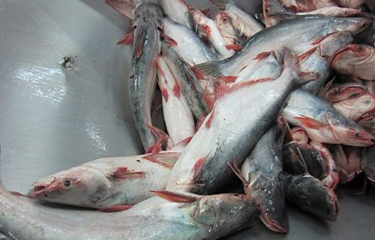
The European markets that saw some of the biggest increases included the Netherlands, with USD 38.1 million (EUR 32.6 million), up 43 percent year-on-year; and Italy, with USD 14 million (EUR 12 million), up 83.1 percent year-on-year.
A representative from Vinh Hoan – the top global exporter of pangasius from Vietnam – confirmed this latest export value increase with SeafoodSource during the Vietfish conference and exhibition, taking place in Ho Chi Minh City, Vietnam, from 22 to 24 August.
“In the beginning months of this year we were not able to fully meet demand from Europe due to material shortage. The surge in export value is understandable because they have to add new volumes when storage runs out,” according to the Vinh Hoan representative.
Feedback from various supermarkets in the E.U. has also shown an increase in consumption of Vietnamese pangasius.
“The increase could have been higher if we were able to provide more supply,” the Vinh Hoan representative added, attributing the rise to Vietnam’s marketing efforts to raise the good image of pangasius in the European Union.
At least two other sales executives from two major pangasius exporters confirmed the value of sales to the E.U. has risen recently.
“Our sales to E.U. have been quite good so far and we plan to export more for the rest of the year,” one executive said.
In contrast, the value of exports from Vietnam to the bloc had experienced a continuous nosedive from 2012 following what Vietnam called “fake news” in Europe against the products from Mekong Delta. In 2017, the country saw another dip, exporting pangasius worth USD 203 million (EUR 173.7 million) to the European Union, down 22.2 percent from 2016.
- Details
- Written by Super User
- Category: NEWS
- Hits: 813
Ngày 17/10, Ủy ban châu Âu vừa thông qua việc đệ trình Hiệp định thương mại tự do Việt Nam – EU (EVFTA), chuẩn bị cho việc ký kết và hoàn tất tiến trình.
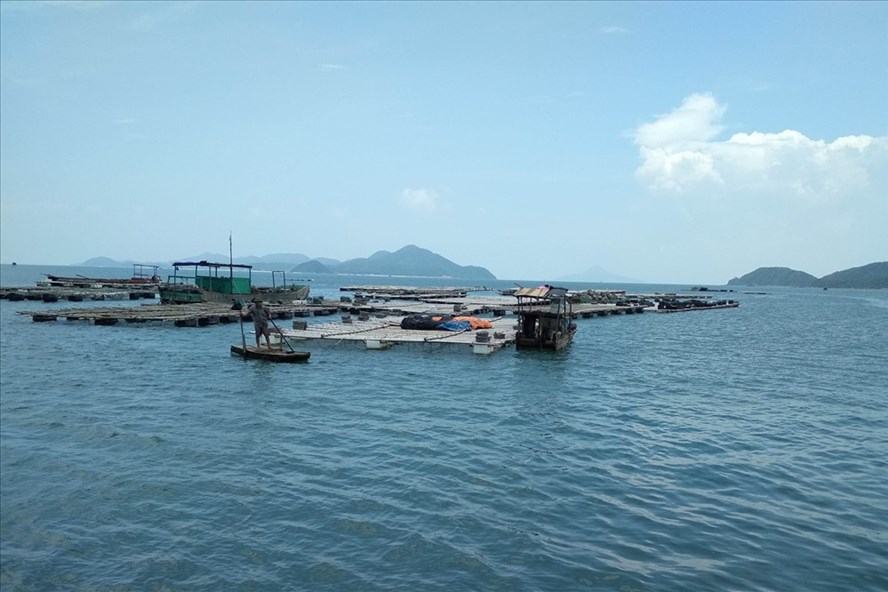
Các doanh nghiệp xuất khẩu thủy sản Việt Nam đang đứng trước cơ hội rất lớn xuất khẩu vào thị trường EU rộng lớn khi Hiệp định thương mại tự do Việt Nam – EU có hiệu lực. Theo đó, đối với mặt hàng thủy sản, Hiệp định EVFTA sẽ xóa bỏ thuế quan hoàn toàn (trừ cá ngừ đóng hộp và cá viên) với lộ trình dài nhất là 7 năm, cá ngừ đóng hộp áp dụng hạn ngạch thuế quan là 11.500 tấn. Bên cạnh đó, khi Hiệp định EVFTA được ký kết sẽ tạo ra cơ hội để các doanh nghiệp thủy sản Việt Nam mở rộng thị trường xuất khẩu, đặc biệt là các thị trường mới như Hà Lan, Tây Ban Nha, Ý… Đồng thời, nâng cao khả năng cạnh tranh của hàng thủy sản Việt Nam so với nhiều đối thủ chưa tham gia các FTA.
Hiện mặt hàng tôm, cá tra, cá ngừ là một trong những mặt hàng xuất khẩu chủ lực của Việt Nam sang thị trường EU. Đối với sản phẩm cá ngừ, Thái Lan, Trung Quốc đang là hai đối thủ lớn nhất của Việt Nam, nắm giữ nhiều thị phần xuất khẩu nhất nhưng cả hai quốc gia trên đều chưa ký kết FTA với EU. Điều này đồng nghĩa với sản phẩm cá ngừ của Việt Nam có lợi thế tuyệt đối về thuế so với hai nước trên tại hai khu vực thị trường lớn là EU.
Tương tự với sản phẩm cá ngừ, Việt Nam hiện đang đứng thứ 2 thế giới về xuất khẩu các sản phẩm tôm với thị phần 14%, đứng đầu là Ấn Độ với 15% thị phần. Sau khi EVFTA có hiệu lực, Việt Nam sẽ được cắt giảm thuế nhập khẩu tôm nguyên liệu và cả thuế xuất khẩu tôm chế biến vào EU, trong khi đó quá trình đàm phán FTA giữa Ấn Độ và EU cũng đang bị tạm ngưng. Đây được xem là cơ hội để sản phẩm tôm xuất khẩu Việt Nam vươn lên cạnh tranh vị trí xuất khẩu hàng đầu với Ấn Độ dành lấy thị phần tại thị trường này.
Đối với các sản phẩm thủy sản cạnh tranh về giá hiện nay là rất lớn trong khi đó mức thuế xuất khẩu thủy sản vào một số thị trường hiện nay rất cao. Cụ thể, tôm xuất khẩu của Việt Nam vào khu vực EU có mức thuế trung bình là 6 - 20%, mặt hàng cá ngừ cũng có mức thuế từ 11 - 20%. Vì vậy khi EVFTA có hiệu lực, việc cắt giảm các dòng thuế sẽ giúp sản phẩm thủy sản Việt Nam hạ giá thành đáng kể, nâng cao khả năng cạnh tranh và kim ngạch xuất khẩu. Mặt khác, ngoài các lợi thế về mặt thuế quan, ngành thủy sản Việt Nam cũng có thêm nhiều cơ hội thu hút đầu tư nước ngoài, nâng cao công nghệ sản xuất và chất lượng sản phẩm.
Trong 9 tháng đầu năm 2018, kim ngạch xuất khẩu thủy sản của Việt Nam sang thị trường EU đạt 1,111 tỷ USD tăng 6,2% so với cùng kỳ năm 2017. Trong đó, Thị trường EU đứng đầu về nhập khâu tôm của Việt Nam, kim ngạch xuất khẩu sản phẩm tôm sang thị trường EU trong 9 tháng đầu năm 2018 đạt hơn 648 triệu USD, tăng 11,1% so với cùng kỳ năm 2017, chiếm 24,7% tỷ trọng xuất khẩu sản phẩm tôm của Việt Nam. Xuất khẩu cá tra của Việt Nam sang thị trường EU đạt hơn 176 triệu tăng 14,6% so với cùng kỳ năm ngoái.
Văn Thọ
- Details
- Written by Super User
- Category: NEWS
- Hits: 904
Supplies of octopus and squid appear to be tighter this year. As a consequence, prices have started to go up and they will keep rising. The developing trade war between the United States of America and China is also contributing to problems.
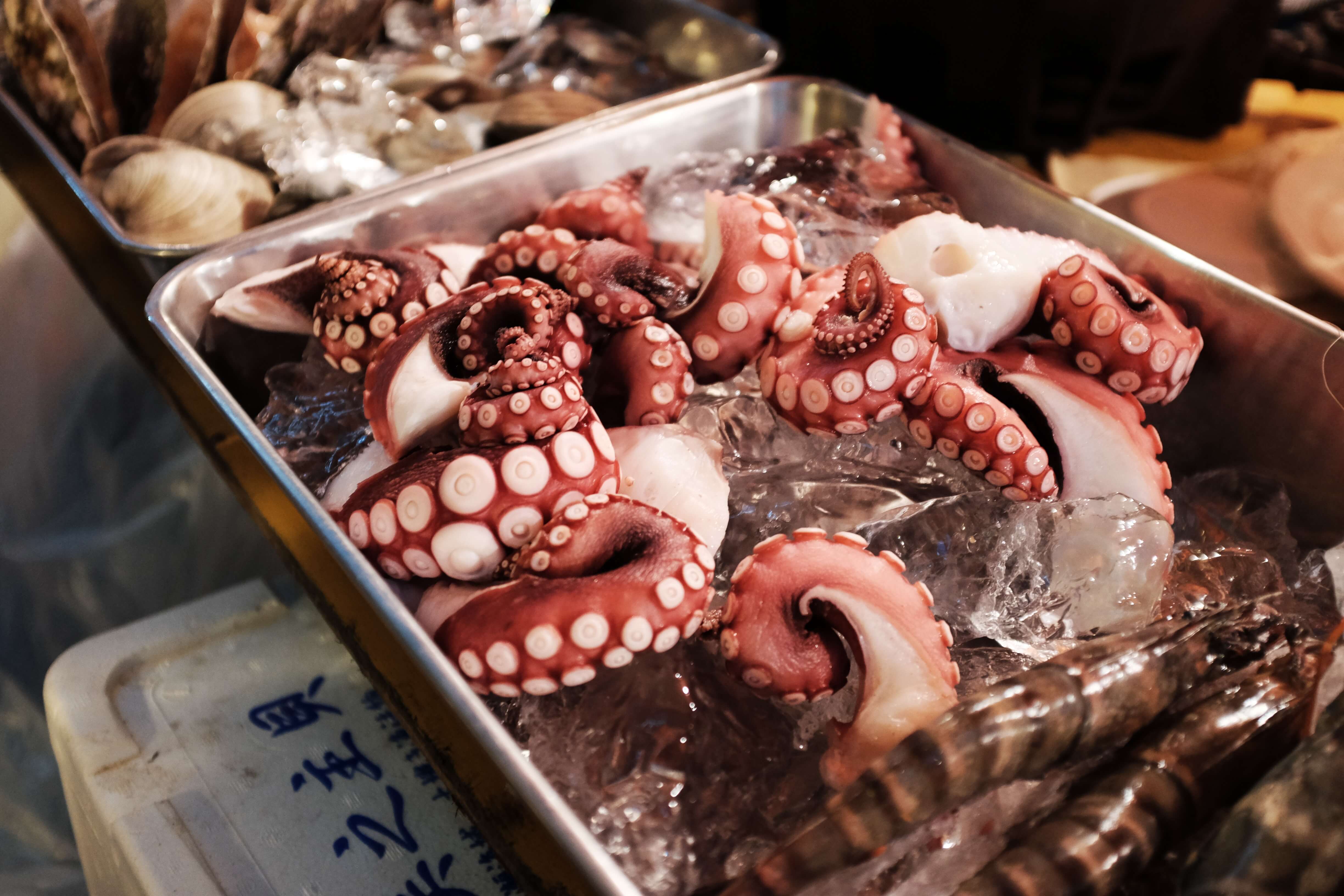
Octopus
There was a lack of octopus in the market in the spring this year. Landings both in Morocco and Mauritania were low. The lack of supplies pushed prices up dramatically.
Morocco’s octopus season was delayed by one month until 30 June. The Government took this action after consulting with the industry. Last season, only 65 percent of the total quota was landed. Catches have been declining for some time and the delayed season is an attempt to improve the resource.
The Sustainable Fisheries Partnership (SFP) has announced that it has established a fishery improvement project in order to promote sustainable octopus fishery in Mauritania. The Mauritanian octopus fishery is an important source of supply to the global cephalopod market, and it is desirable to bring this fishery to a sustainable state.
The Scientific Certification Systems Global (SCS Global) has been undertaking a pre-assessment of the sustainability of an octopus fishery off the coast of the Yucatan Peninsula in Mexico. The octopus fishery and the red grouper fishery represent the most important resource in this region, with an annual catch fluctuating between 9 000 and 16 000 tonnes.
Trade
Octopus prices on world markets have been very high recently. In April, prices on the US market were 28 percent higher that in 2016, according to Spanish exporter Discefa. Prices for Moroccan frozen on board octopus reached USD 17.00 per kg for size T1.
Viet Nam’s exports of octopus and squid are increasing dramatically this year. According to figures published by the Viet Nam Association of Seafood Exporters and Producers (VASEP), exports of cephalopods to the Russian Federation during the first three months of 2018 amounted to over USD 1 million, up almost nine times compared to the same period in 2017. The Russian Federation is now one of the most important markets for Vietnamese octopus and squid, and accounts for more than 90 percent of the export value of Viet Nam’s octopus.
Japanese imports of octopus in the first quarter of 2018 totalled to 8 900 tonnes, slightly up compared to 2017. However, there were changes in the suppliers. Morocco and China experienced reduced shipments to Japan, while Viet Nam saw an increase.
Korean imports of octopus have been on a declining trend for some time, but during the first three months of 2018, the trend levelled off. Imports during this period in 2018 amounted to 16 400 tonnes, just 4.5 percent less than in 2017.
Squid
The Peruvian Ministry of Production (PRODUCE) set the quota for the 2018 giant squid fishery at 609 000 tonnes. This quota may be changed later, based on recommendations from the Maritime Institute of Peru (IMARPE). The stock is in good shape, according to the Ministry. Average annual catches of giant squid in Peru have been around 500 000 tonnes for several years.
Illex squid catches inside Argentine waters have been good. During the first three months of the year, Illex catches were up by 15 percent over last year. This fishery started earlier than usual this year because many Chinese and Taiwanese vessels were already active just outside the Argentine exclusive economic zone (EEZ). During the second quarter of the year there have been reports of very poor production.
For the Chinese (mainland and Taiwan Province) vessels operating outside the EEZ, the shortfin squid fishery has been disappointing. As the fishery drew to a close in late April, vessels operating in international waters off Argentina had caught 110 000 tonnes of squid. This was just half of the volume caught by these vessels in 2017. Observers expected prices to rise as a consequence. Much of this catch was destined for China, and Chinese prices for squid were already rising in late April.
The Loligo fishery in the Falkland Islands (Malvinas) also started very well. During the first month some 20 000 tonnes were landed. A survey carried out in February indicated that there were aggregations of small squid only in the southern region. Soon after the fishery started, larger aggregations of squid were found also in the north. Because of the smaller size of the squid found in the south, this fishery was closed for a week at the end of March for conservation purposes.
Trade
Poor catches by Chinese vessels operating just outside the Argentine EEZ contributed to increasing prices of practically all species of squid in China. Reported catches per vessel were down to 300¬500 tonnes, while average catch per vessel last year was about 800 tonnes. Prices were up by 2¬6 percent in mid-April compared to the beginning of 2018. Prices for Todarodes pacificus squid, which is caught mainly in East Asia, were also up.
US President Trump’s trade war is creating negative effects for US seafood exporters even before it is in effect. Chinese squid importers stopped ordering US squid because they feared shipments would not reach them before the 25 percent extra import tariff goes into effect in mid-July. This is also unfavourable for the US squid industry. In 2017, about half of the US exports of squid went to China. China imported 34 700 tonnes of squid worth USD 92.8 million. The second largest importer of US squid was Viet Nam, which imported 8 900 tonnes, and the third largest importer was Japan, with 8 100 tonnes. Chinese importers are looking for other suppliers, which are difficult to come by because of lower production overall. Consequently, squid supplies may be very tight in the coming months, and prices will be high.
Japanese imports of squid and cuttlefish marginally declined during the first three months of 2018 compared to the same period in 2017. Total imports of these species went down from 36 400 tonnes in 2017 to 30 900 tonnes in 2018 (-15.1 percent). China is by far the largest supplier, accounting for 73.4 percent of the total.
China exported 12 percent more squid and cuttlefish in the first three months of 2018 than in the same period in 2017. Total exports amounted to 131 100 tonnes. The main markets were the Republic of Korea, Japan and Thailand. Chinese imports of the same products remained level. Total imports of squid and cuttlefish during the first quarter of the year reached 42 000 tonnes, with Indonesia and the United States of America being the two main suppliers.
Spanish imports of squid and cuttlefish declined from 57 300 tonnes during the first three months of 2017 to 50 900 tonnes during the same period in 2018 (-11.2 percent). The main reductions were registered in exports from “other countries”, while the main supplier, China, held its own, and the second largest supplier, the Falkland Islands (Malvinas), increased its shipments by 262 percent.
US imports of squid and cuttlefish during the first three months of 2018 declined slightly by 1.3 percent to 17 700 tonnes. Imports from the largest supplier, China, accounted for as much as 61.7 percent (10 900 tonnes). Other major suppliers included India (10.4 percent of total) and Taiwan Province of China (7.6 percent of total).
Outlook
The cephalopod market should expect tight supplies, especially for squid, but also for octopus. While catches inside Argentina’s EEZ have been fairly good, catches by foreign vessels outside this EEZ have been poor. In addition, the developing trade war between the United States of America and China is creating supply problems. Prices have come up noticeably, and may go further up.










